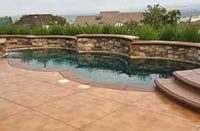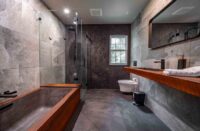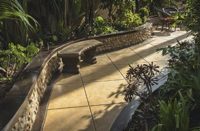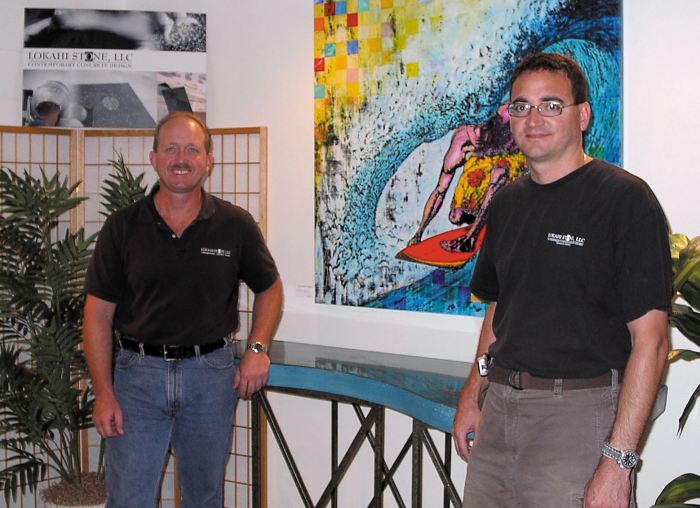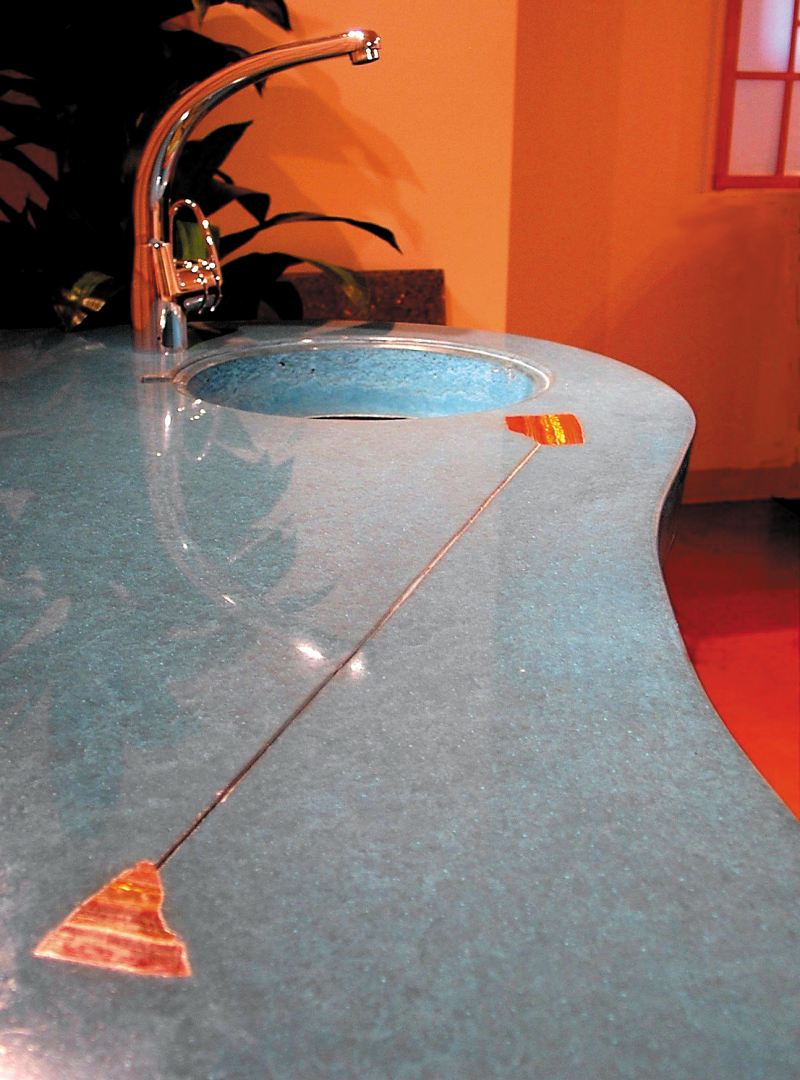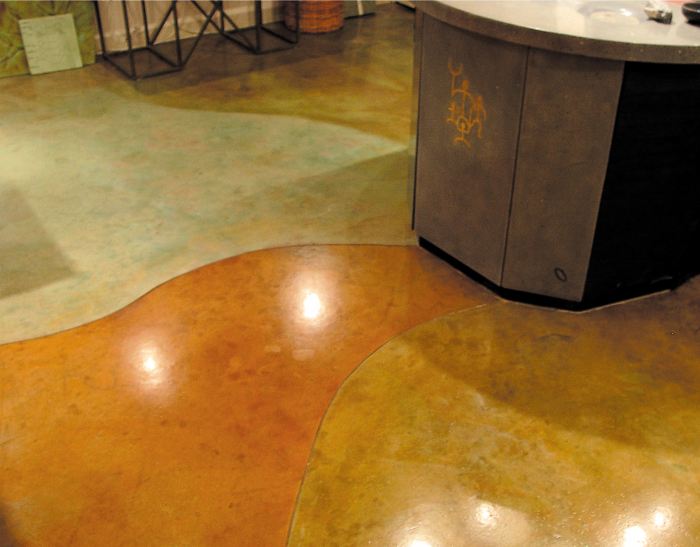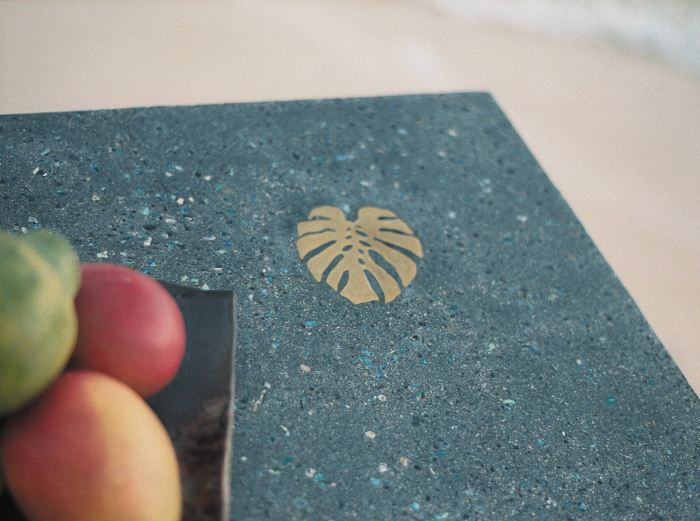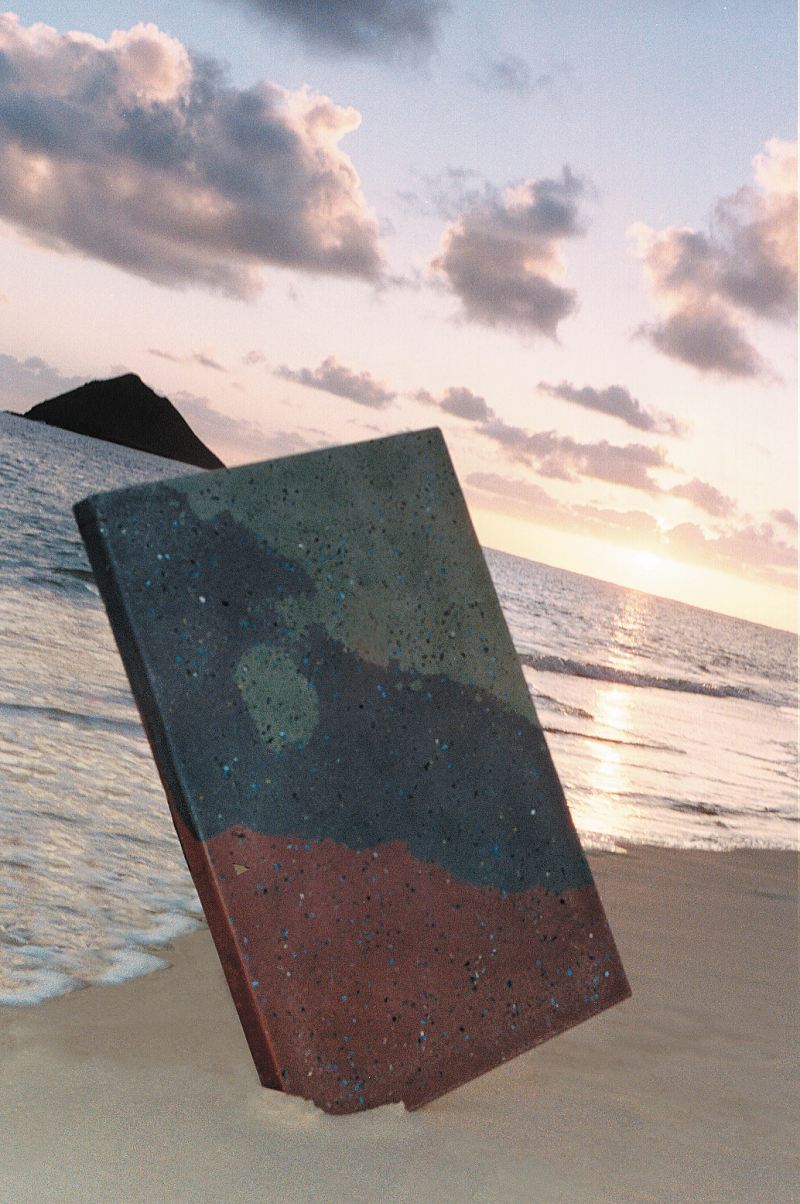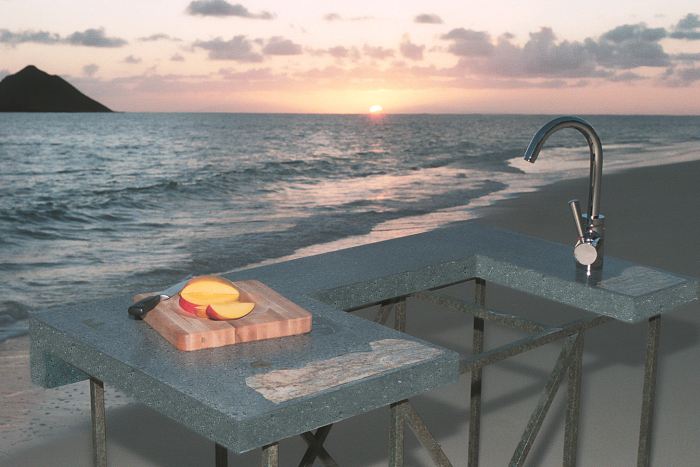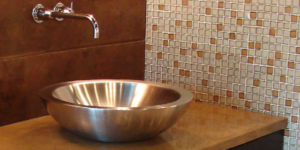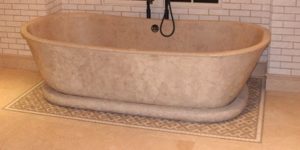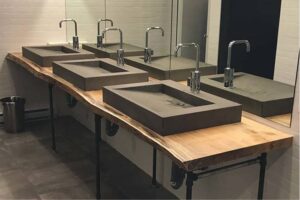Their seven-person company, Lokahi Stone, quickly filled a niche in Hawaii’s thriving construction industry. The company specializes in custom-made concrete countertops and sinks, furniture and flooring. Lokahi Stone’s work is sometimes embellished with imprints of native ferns or inlays based on ancient Hawaiian petroglyphs, touches that ground the finished product in the place it was created. Concrete Decor interviewed Andrew Simon to learn about the company and the state of decorative concrete in Hawaii.
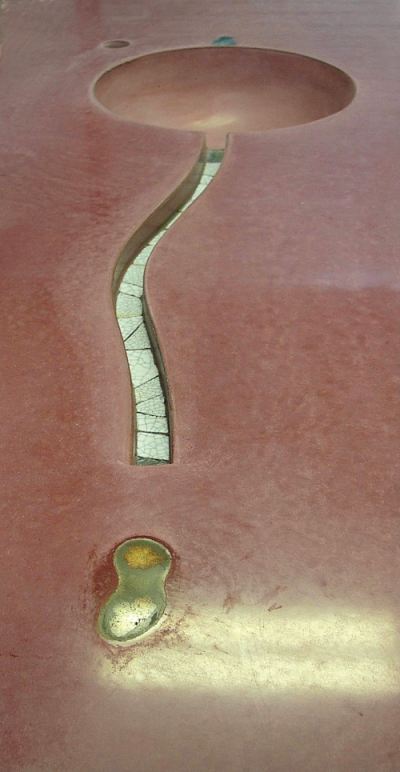 What’s the story behind Lokahi Stone?
What’s the story behind Lokahi Stone?
Jamie and I were both caught up in the corporate culture of a major international construction engineering firm. My background was in project controls, finance and accounting. Jamie’s focus was engineering and project management. It was the end of another overseas contract that got our minds thinking about what’s next — continue as cogs in the machine, or break the mold and begin anew?
Jamie’s field-management experience and his experience as a tradesman working with concrete enabled Lokahi Stone to obtain a general contracting license. My experience in project controls enabled us to effectively manage the company from the financial and business perspective. Our mix of talents and our shared focus on creativity make for a very effective partnership. Having acquired a passion for the ocean and warm weather from our previous experience working contracts in the islands of the Pacific, we decided to form Lokahi Stone in trade-wind and sun-drenched Hawaii.
How’s business?
Business is booming right now. With the way real estate is all over the islands, many families are remodeling their homes with proceeds from refinancing. And a lot of people are returning to the simplicity of concrete flooring after years of wall-to-wall carpeting. Concrete floors are easy to maintain and cool to the touch — perfect for our climate and lifestyle.
How popular is decorative concrete in Hawaii?
It’s catching on in the islands thanks to increased press and familiarity with the medium. Hawaii is influenced by the mainland through tourism and the many people who move here from places where decorative concrete reigns supreme. I can’t count the number of times someone sees our showroom and exclaims, “I saw this floor in San Francisco and always wanted it in my home!” Or: “Do you guys do work in Arizona? I saw this countertop at a restaurant there. You must have made it!”
What’s your showroom like?
Our showroom, which is attached to our studio/workshop, is always a work in progress. It’s about 800 square feet, and has many examples/vignettes displaying our floors and countertops. Three rooms show different scenarios of floor treatments, from acid staining on an aged warehouse floor through overlay products and stamped concrete. Each room also displays concrete counters of every shape, size and color. Local artists display their work on the walls, from pop-art paintings to locally built surfboards.
How do you market yourselves?
To reach homeowners, we have been marketing our company through a local remodeling magazine. However, our main focus is designers, architects and builders. This requires more than advertising, and requires time spent in introductions and networking, as well as word of mouth, et cetera. Oftentimes we are called upon by architectural firms to make presentations about our product and its uses. Although concrete is by no means new to the islands, decorative concrete is.
What are some of the more notable jobs you’ve done?
Commercially, we have done work for Starbucks and Jamba Juice, as well as other established businesses. Residentially, some of our more notable jobs involved poured-in-place shower stalls, concrete sinks, and ground, integrally colored floors similar to terrazzo.
Do you prefer cast-in-place applications or casting off site?
I don’t really have a preference, but we cast most of our work off site in our studio. This method allows for greater quality control, versatility and expression. Forms can be made in the studio that are impossible to make on site, where most pieces are finished with a trowel. Three-dimensional works — inlays, drain-boards, bowls, et cetera — are more easily achieved and more beautifully executed in our studio.
That said, you can’t beat the massiveness of a large, poured-in-place, monolithic piece. However, that look does not come without a cost. Poured-in-place work requires a client who is willing to have forms, workers and a mess in their home for a while. If at all possible, large monolithic pours should take place when construction is in its early stages.
Often, our poured-in-place walls and surrounds are topped with off-site cast counters — the best of both worlds.
Do you literally break the mold after you complete every piece?
We actually do break the molds each time. No two pieces are exactly alike, and no two molds are alike. Our clients like knowing that their pieces are one of a kind, and we like providing a product that is as much art as it is functional —functional art, in other words.
We know you do a lot of acid staining and integral coloring. Do you ever use dyes or acrylic stains?
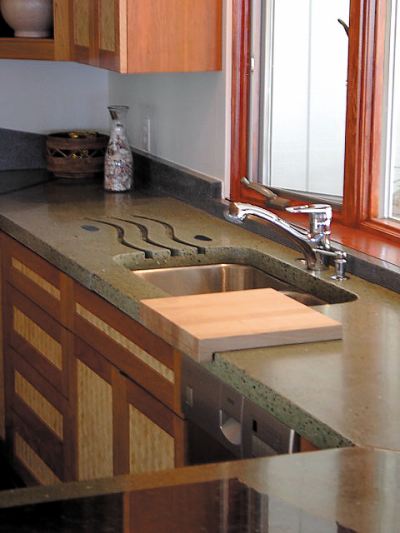 We haven’t done a lot of experimenting with dyes and acrylic stains. I think that’s because, in our minds, the colors and effects do not mimic nature. They’re too flashy. I guess this is an area we need to explore some more.
We haven’t done a lot of experimenting with dyes and acrylic stains. I think that’s because, in our minds, the colors and effects do not mimic nature. They’re too flashy. I guess this is an area we need to explore some more.
How do you create those petroglyph inlays?
The petroglyphs we use are bronze replicas of actual Hawaiian petroglyphs found around the islands. A local artist forms the images and has them cast on the mainland. We create imagery in brass, stainless steel and bronze, using high-pressure water-cutting and CAD. With this method, you can recreate and use any image as an inlay.
How has Fu-Tung Cheng influenced your work?
Jamie and I have always admired Fu-Tung Cheng’s work, and it was his book “Concrete Countertops” that started this whole venture. Years before starting Lokahi Stone, Jamie purchased a condo and began remodeling. It took the patience of a cabinet maker who let us use his shop (in return for a cabinet contract), and several weeks of “vacation” to produce our first concrete countertop. That countertop is still a beautiful — albeit crude, compared to our more recent works — testimonial of what you can achieve with the right willpower and desire.
Since Lokahi Stone started, we’ve had the pleasure of working with Fu-Tung Cheng on jobs here in Hawaii, and sharing the spirit of Aloha with Cheng Design. Likewise, Jamie and I have both advanced our expertise by attending Cheng Design’s seminars and being members of the Cheng Concrete Exchange from its inception.
You guys won the Best Decorative Finishes category in the Cheng Concrete Exchange’s design competition.
What’s the story behind your winning counter?
We created that project in association with Building Industry Association of Hawaii’s 2004 home show. The theme of this display was “build green,” and it highlighted many “green” products and energy-efficient appliances. We made our counter with recycled glass aggregates, discarded marble tailings, and found objects. In our business, it is surprising what treasures you can find in the local junkyards! It takes a creative eye to pick out objects that will ultimately make beautiful inlays. Wherever I travel, I keep a keen eye out for interesting objects, from automobile parts to fossils and polished minerals. The sky is the limit.
Here too is an area where the client can play a part in the design process. We’ve had many clients bring their own keepsakes, beach glass, found objects and heirlooms to our shop. Many even want to place them themselves. It really makes a client feel a part of the process, and lets them say, “I helped make it!”
What are your long-range plans?
Our plans include expansion to both the islands of Hawaii and Maui, and possibly the West Coast.
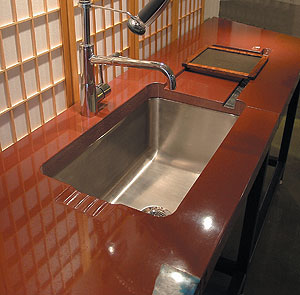 What drives you guys to do such beautiful work, and do you consider decorative concrete an art form?
What drives you guys to do such beautiful work, and do you consider decorative concrete an art form?
Decorative concrete is definitely an art form. Our clients seek our work because each piece is a unique expression. Artisans, not machines, craft each piece. It is apparent in each work, not unlike the finger marks in handmade pottery or the brush strokes of Van Gogh. Around here, each day holds new surprises. Having spent so many years in the corporate conundrum, where creativity is as desolate as individuality, we needed a change. I’ve always had an unsatiated creative side that decorative concrete fulfills.
